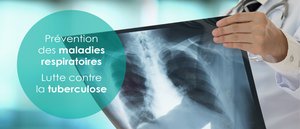Prevention of tuberculosis and respiratory diseases
 | The Ligue is strongly committed to the prevention of the Tuberculosis: this mission was officially entrusted to it by the law of 19 March 1910. Tuberculosis is an infection caused by contact with droplets containing the tuberculosis bacillus suspended in the air. Like the common cold or flu, tuberculosis is spread through relatively incidental contact. |
The only way to prevent the transmission of the bacillus is to detect and cure contagious patients. The Ligue's medico-social centres offer tuberculin tests and, if necessary, radiological examinations to prevent the spread of the disease and to treat patients already affected.
Like the common cold or flu, tuberculosis (TB) is spread through relatively casual contact, although repeated infection is usually necessary. The people most at risk are those who are in close contact with an infected person (family members, friends, work colleagues) as well as people in contact with sick people in poorly ventilated premises.
Any person infected with tuberculosis is likely to remain infected for the rest of his or her life. Fortunately, most infected people never develop the disease. The risk of developing tuberculosis during the life is estimated at 5-10%.
Although there is no certainty, we estimate that between 50 and 100 million people are infected with forms of tuberculosis that are resistant to some or all of the drugs used to treat the disease. These people are no more likely to develop TB than those infected with a common form of TB.
Nearly 5 million people infected with TB are also infected with the HIV virus. While this number represents a small proportion of tuberculosis cases, it accounts for one-third of people infected with the HIV virus. The risk of developing tuberculosis for these people is 25 times higher.
The symptoms of tuberculosis are as follows:
- coughing (sometimes accompanied by bloody sputum),
- great fatigue
- night sweats
- emaciation
- chest pains
If left untreated, more than 50% of patients die. With adequate treatment, the cure rate reaches over 95%. However, the chances of recovery are considerably reduced if the patient is infected with a chemoresistant form of tuberculosis or if he or she lives in a country without an effective tuberculosis control programme.
There is a 50% chance that a person with tuberculosis will infect others if he or she is in contact with them for at least 8 hours a day for at least 6 months.
A patient under treatment ceases to be contagious after 2 to 3 weeks.
A person who is not sick but infected with the tuberculosis germ is not contagious.
Patients on treatment can continue to eat, sleep and work with other people as long as certain precautions are taken. After a few weeks of treatment, patients are no longer contagious. However, it is essential that they continue to take the prescribed medicines.
Tuberculosis is transmitted by humans, not by insects, blood transfusions or water. Specifically, it is transmitted by patients who are untreated or who do not follow the prescribed treatment for at least six months. One untreated case of tuberculosis can infect 10 to 14 people in a year. Effective treatment is essential not only to cure sick people but also to prevent the spread of the infection.
The only way to prevent the transmission of the bacillus is to detect and cure contagious patients. The Ligue's médico-social centres offer tuberculin tests and, if necessary, radiological examinations to prevent the spread of the disease and to treat patients already affected.
Download now the information brochure Tuberculosis Essentials.
